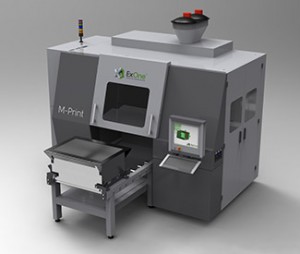Materials research is vital to those concerned with advancing the capabilities of 3D printing. Many materials are proprietary, likely causing a number of groups to simultaneously pursue some of the same work to push the boundaries of what properties a material can sustain after being 3D printed. There are many universities and research departments out there that could greatly benefit from getting their hands on advanced industrial 3D printers to test, compare, and explore what the best machines can do.
ExOne has some of the most sophisticated industrial 3D printers on the market, and,to give universities and researchers access to the company’s proprietary processes and materials, they’ve released a new 3D printing system called Innovent. While ExOnesells their machines and printed products to industrial customers around the world, they are also developing a laboratory line of systems that began with the X1-Lab 3D printer.
Innovent is an industrial-grade, lab-sized machine, beneficial for testing material properties in universities and research laboratories, as well as research and development (R&D) departments at commercial organizations. According to ExOne, Innovent is unique because it “balances a specific build box for the technical qualification of materials with a smaller overall lab machine platform size, when compared to other industrial-grade 3D printers.”
- Kent Rockwell, Chairman and CEO of ExOne, said, “Innovent expands upon ExOne’s lab machine offerings by allowing customers, whether they are educators or companies, the ability to qualify materials, an option not previously available in these types of 3D printers. ExOne is improving its laboratory solution to help drive the overall industrial sector towards increased experience with and use of binder jetting 3D printing.”
Innovent uses similar techniques to other ExOne machines, in that it relies on a print head to “dispense micro-droplets of specially-engineered binder into very thin layers of powdered metal.” So, what are the big differences between the Innovent and the X1-Lab? Innoventoffers eight times the build volume – measuring at 65mm x 160mm x 65mm – and is part of a larger system that includes and oven and furnace.

With the Innovent, the material capabilities of ExOne’s systems are that much more within reach of education and research institutions. Materials that include: engineered sand, bronze, stainless steel, tungsten, titanium, and single-crystal, aerospace materials. Now, we wait to see what those education and research clients will do with them.





